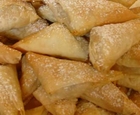|
Greek Appetizers Cheese Triangles Like their better known cousins, Spanikopitas, these tasty pastry triangles are filled with cheese instead of spinach.
Filling: mix cheeses together, and blend in eggs. Filo Dough: place 1 filo sheet horizontally on a counter and brush lightly with melted butter. Place a second sheet on top and brush it. With the two sheets stacked together, use a sharp knife to cut them the short way, into 5 strips (2 1/2 or 2 3/4" wide). Be sure to cover the remaining dough with plastic wrap or slightly damp towel to keep it from drying out. Assembly: Now you're going to fold a flag—remember from Scouts? First, though, preheat oven to 350. Now for the flag: place 1 tsp. filling on a strip, 1" from bottom. Fold bottom right-hand corner diagonally, to meet left-hand edge, making a triangle. Then fold straight upward, against the triangle’s top horizontal edge. Fold diagonally again. This time fold the lower-left corner to meet right edge. Then fold straight up, again, and so on—just like a flag. Use a drop of water on your finger to paste down the final flap.* Place filled triangle on a greased cookie sheet and brush with butter. Make all 30 spanikopitas, place in oven and bake for 20-25 minutes till golden. Serve warm. * At this point, you can freeze the triangles. When you’re ready to cook, brush them with the butter and place them, still frozen, into the oven for about 40-45 minutes, till golden. |
Tips & Glossary You may not have a number of ingredients used in Greek cooking in your spice shelf, but you can find them at Mid-Eastern food stores. So to avoid frustration, make a list of the items you need before trying out the recipes. Filo: aka phyllo, paper-thin sheets of raw, unleavened flour dough. Purchase frozen in most grocery stores and follow directions on package for thawing. When working with a sheet, keep others covered with a damp towel to prevent drying out. Grape Leaves: Grape leaves are sold canned in salted oil. Rinse off the salt before using. If you want, prepare your own: find fresh, tender young leaves and plunge them for 1 minute into boiling water (with 1 or 2 T lemon juice). Then proceed with recipe. After blanching, you can freeze them for later use. Here’s how: blanch as above, dunk in iced water, pat dry with towels, and seal in an air-tight plastic bag. They're safe for 6 months, but use quickly when thawed. Nutmeg: Use small whole nuts and store them, tightly covered, in a dry dark area. Grate what you need using the smallest grating edge or grind in a food processor. What a difference from store bought nutmeg! Pine Nuts: edible seeds of pine trees used in many Greek dishes. Before cooking, release flavor by lightly browning in a heated skillet Skewers: Use metal or wooden skewers for kebobs. If wooden, soak 30 minutes before using to prevent them from catching on fire. Rosewater: distilled from rose petals and used to flavor Mid-Eastern and Asian cooking. You can make your own. But, seriously, why would you? Purchase it at Asian or Mid-Eastern stores. Semolina: aka farina or Cream of Wheat; a coarsely ground wheat grain. You also know it as couscous. If made from durum wheat, it is used to make pasta. Tarama: poor-man's caviar. From carp roe, it is pinkish-orange and is what (along with food dye) gives taramasalata its lovely color. Buy it jarred in Mid-Eastern food stores.
|
Site by BOOM
![]()
LitLovers © 2024

